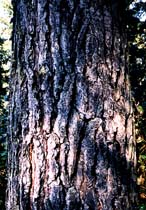
Bark of a 50 cm diameter specimen at Patrick Point State Park, CA [C.J. Earle, May-1999]. |
Pinus muricata
D. Don 1836
Common NamesBishop, pricklecone, dwarf marine, Obispo, umbrella (2) or Santa Cruz Island pine (3).Taxonomic notesSyn: Pinus edgariana Hartweg 1848; P. muricata var. anthonyi Lemmon 1892; P. muricata var. borealis Axelrod nom. inval. (holotype not cited); P. muricata var. stantonii Axelrod nom. inval. (holotype not cited); P. remorata H. Mason 1930; P. muricata var. remorata (H. Mason) Silba; P. muricata f. remorata (Mason) Hoover (10). (4).Trees with small symmetrical cones, found mainly toward the southern end of the species' range, are sometimes treated as P. remorata , but analysis by Hoover (8) showed this character to be inconsequential; he treated it as a forma , the lowest rank of botanical recognition. The earliest name at varietal rank for trees with small symmetrical cones is Lemmon's var. anthonyi , a name overlooked by many subsequent authors. Trees in the north of the range differ in having glaucous foliage and a taller, narrower crown habit; see further under Remarks, below. "The several varieties described for Pinus muricata reflect the high variability in leaf characters and in degree of elaboration of apophysis and umbo in this species. The extremes can sometimes occur together" (4). DescriptionTree: Height to 24 m; trunk to 90 cm dbh, straight to contorted, crown rounded, flattened, or irregular (4).Bark: Dark gray, deeply furrowed, ridges long, scaly-plated (4). Branches: Spreading-ascending, often contorted (4). Shoots: Stout to slender, orange-brown, aging darker brown, rough (4). Leaves: Two per fascicle, spreading to upcurved, persisting 2-3 years, 8-15 cm × (1.2-)1.5(-2) mm, slightly twisted, dark yellow-green (glaucous blue-green in northern populations), all surfaces with stomatal lines, margins strongly serrulate, apex abruptly conic-acute; sheath to 1.5 cm, base persistent. Buds ovoid-cylindric, dark brown, 1-2.5 cm, resinous (4). Cones: Maturing in 22-24 months, serotinous, persisting for up to 70 years (or more; longer than any other pine), mostly in whorls, mostly asymmetric, lanceoloid-ovoid before opening, curved-ovoid when open, 4-9 cm, rich glossy chestnut-brown, sessile or on stalks to 2-4 mm long, mostly downcurved (4, 13). Cone scales: Have a deep red-brown* border distally on adaxial surface; apophyses usually much thickened (but not on symmetrical cones), the abaxial ones progressively more angulately dome-shaped toward base of cone; umbo central, a stout-based, curved claw (4). * This border (the sealing band) is yellow-brown on freshly opened cones, darkening through orange and deep red-brown to deep purple on exposure to light and/or oxygen over a year or so in the herbarium; same colour changes on e.g. P. radiata, P. attenuata , etc. (13). Pollen cones: Ellipsoid, to 5 mm long, orange (4). Seeds: Obliquely ellipsoid; body 6-7 mm, dark brown to near black; wing 15-20 mm. 2 n =24 (4). Wood: Similar species: RangeUSA: Coast of C and N California, and Santa Cruz and Santa Rosa Islands; Mexico: Baja California Norte, locally on the mainland, also on Isla Cedros in SW Baja California Norte (1). See also (14). Habitats include dry ridges to coastal, windshorn forests, often in or around bogs; at 0-300 m elevation. The species is rare enough to be of conservation concern (4).Big TreeDiameter 139 cm, height 34 m, crown spread 12 m. Locality: Mendocino County, CA (7).OldestDendrochronologyEthnobotanyUSDA hardiness zone 8.ObservationsCan be seen along the northern end of Inverness Ridge at Point Reyes National Seashore.RemarksThe numerous cones remain closed, even when enveloped by the wood of the growing trunk. The common name is derived from the pine's 1835 discovery near the mission of San Luis Obispo in Alta California (3)."The species P. muricata is quite variable in terms of morphological, genetic, geographical, physiological, ecological and chemical characteristics. Research by Millar (1983, 1986) and Lloyd (1975) has attested to a steep cline within the species. Pinus muricata is divided into four varieties [not all validly published; see taxonomic notes, above]: muricata, borealis, remorata , and cedrosensis . The differences between the varieties are based on tree size, foliage, bark, and cones. Millar (1983) states that in northern California, a continuous population extends 180 kilometers from Ft. Ross to Ft. Bragg with several morphological and biochemical characteristics changing abruptly at Sea Ranch (27 km north of Ft. Ross). The northern population is called the blue strain (due to the blue colored cast to the foliage) and the southern population is called the green strain (due to deep green foliage). The differences in the strains are related to stomatal anatomy, waxiness of needles, monoterpene composition, allozymes, and the flowering phenology. It is thought that the evolution of these different strains is due to population biogeographic movement and adaptation to unique soils. Millar (10) felt that sufficient allozymic variation exists to encourage isozyme analysis for further genetic studies with Bishop pine" (5). The northern 'blue' trees, probably distinct at subspecific rank or even a separate species, are without a scientific name; Axelrod's [invalid] var. borealis was described from Salt Point, Sonoma Co., about 20 km south of the southernmost 'blue' trees at Sea Ranch, on the Coast Hwy at the Annapolis road junction. They have proved impossible to hybridise with the typical 'green' trees in controlled experiments. (9, 10, 11, 12). The northern 'blue' trees have shown promise as a potential timber tree in Britain and New Zealand, with growth rates of up to 2m/year when young even on very poor sandy soils. Citations(1) Silba 1986 .(2) Peattie 1950 .
(3)
Little 1980
.
(14) Robert S. Thompson, Katherine H. Anderson and Patrick J. Bartlein. 1999. Atlas of Relations Between Climatic Parameters and Distributions of Important Trees and Shrubs in North America. U.S. Geological Survey Professional Paper 1650 A&B. URL= http://greenwood.cr.usgs.gov/pub/ppapers/p1650-a/pages/conifers.html , accessed 22-Jan-2000.
See also:
This page co-edited with M.P. Frankis, Mar-1999. |
|
back | Pinus | Pinaceae | home
This page is from the Gymnosperm Database
|